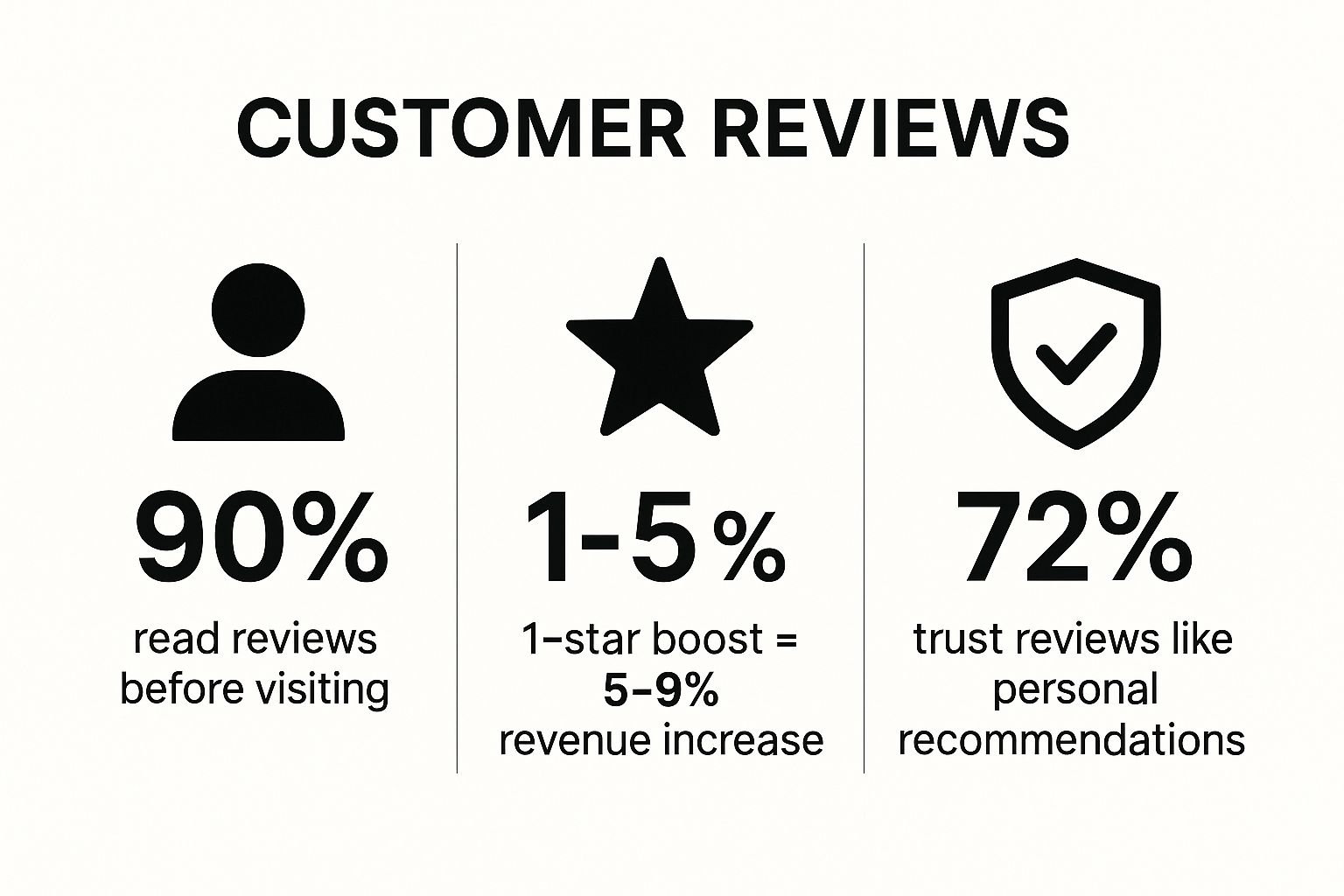In today's competitive market, a strong digital presence is essential for survival and growth. For small businesses, navigating the vast world of online marketing can feel overwhelming, with countless strategies competing for your limited time and budget. The key to success is not doing everything, but focusing on targeted, high-impact strategies that deliver measurable results. This is where a clear plan becomes your most valuable asset.
This guide cuts through the noise to provide a playbook of actionable small business digital marketing tips that you can implement immediately. We're moving beyond generic advice to give you a specific, step-by-step framework. You will learn how to master everything from dominating local search results to building powerful email campaigns that convert.
We will explore eight proven strategies, each designed to be a building block for a comprehensive marketing plan that attracts new customers, builds lasting loyalty, and drives sustainable revenue. Forget theory; this is about practical application. Let's dive into the concrete tactics that will transform your digital marketing efforts from a business expense into a powerful, growth-generating engine.
1. Optimize for Local SEO
For brick-and-mortar businesses, local search engine optimization (Local SEO) isn't just a good idea; it's a fundamental necessity. This strategy focuses on increasing your visibility to potential customers searching for products or services in your immediate geographic area. When someone searches for "pizza near me" or "emergency plumber," Local SEO is what determines whether your business appears in their Google Maps pack or at the top of their search results.
Unlike broad SEO, this approach targets a highly motivated, local audience ready to make a purchase. By optimizing your online presence for local intent, you connect directly with customers actively seeking what you offer, right when they need it. This makes it one of the most effective small business digital marketing tips for driving foot traffic and generating qualified leads.
How to Implement Local SEO
Getting started is straightforward. Your primary tool is your Google Business Profile (GBP), formerly Google My Business. This free listing acts as your digital storefront on Google Search and Maps.
- Claim and Verify Your GBP: This is your first and most crucial step. Fill out every section completely, including your business hours, address, phone number, and services.
- Ensure NAP Consistency: Your Name, Address, and Phone number (NAP) must be identical across all online directories like Yelp, Bing Places, and industry-specific sites. Inconsistencies can confuse search engines and harm your ranking.
- Gather Customer Reviews: Actively encourage satisfied customers to leave reviews. Positive reviews build social proof and are a significant ranking factor for the local map pack.
- Create Location-Specific Content: Write blog posts or create landing pages about local events, news, or case studies. For example, a roofer in Denver could write a post titled "Preparing Your Roof for a Denver Winter."
Implementing these tactics will significantly improve your chances of appearing in high-value local searches. If you want a deeper dive, you can explore comprehensive SEO services for your local business on sugarpixels.com.
2. Leverage Social Media Marketing
Social media marketing is no longer optional; it's a core component of a modern digital strategy. This approach involves using platforms like Instagram, Facebook, and LinkedIn to connect with your audience, build brand loyalty, and drive sales. For a small business, social media provides a direct and affordable channel to engage with customers where they spend a significant amount of their time.
Unlike one-way traditional advertising, social media is a two-way street. It allows you to showcase your brand’s personality, share valuable content, and build a genuine community. From a local bakery sharing behind-the-scenes videos on TikTok to a B2B consultant demonstrating expertise on LinkedIn, these platforms humanize your brand and foster relationships that lead to long-term customer value. This makes it one of the most powerful small business digital marketing tips for building awareness and trust.
How to Implement Social Media Marketing
Effective social media requires a strategic approach, not just random posting. To truly succeed in leveraging social media, developing a winning small business social media strategy is paramount.
- Choose the Right Platforms: Don't try to be everywhere. Focus on 2-3 platforms where your target audience is most active. A B2C boutique might thrive on Instagram and Pinterest, while a tech startup will find more value on LinkedIn and X (formerly Twitter).
- Post with Consistency: Create a content calendar to plan your posts in advance. Consistency keeps your audience engaged and signals to platform algorithms that your account is active and relevant.
- Engage Authentically: Social media is about being social. Respond to comments, answer direct messages promptly, and participate in conversations. Authentic engagement builds a loyal following.
- Utilize High-Quality Visuals: Your content represents your brand. Use high-resolution images and compelling videos to capture attention in a crowded feed. Even simple, well-lit smartphone photos can be highly effective.
By focusing on genuine connection rather than just broadcasting promotions, you can turn your social media channels into powerful assets for business growth.
3. Create Valuable Content Marketing
Content marketing is the strategic approach of creating and sharing valuable, relevant, and consistent content to attract and retain a clearly defined audience. This isn't about direct sales pitches; it's about providing genuine utility to your potential customers through blog posts, videos, guides, and podcasts that educate, entertain, or solve their problems.
By establishing your business as a credible source of information, you build trust and authority in your niche. When customers are ready to buy, they are more likely to turn to the brand that has consistently provided them with value. This makes content one of the most powerful and sustainable small business digital marketing tips for long-term growth and customer loyalty.
How to Implement Content Marketing
A successful content strategy revolves around understanding your audience's pain points and creating content that directly addresses them. Your goal is to become their go-to resource.
- Focus on Solving Problems: Use keyword research tools to discover what questions your target audience is asking online. Create comprehensive content that provides the best answer, such as how-to guides, checklists, or detailed tutorials. A local HVAC company, for instance, could create a seasonal maintenance guide.
- Choose the Right Formats: Not all content has to be a blog post. Repurpose your core ideas into different formats to reach a wider audience. Turn a popular article into an infographic, a short video for social media, or a podcast episode.
- Include a Clear Call-to-Action (CTA): Every piece of content should guide the user on what to do next. Whether it's signing up for a newsletter, downloading an ebook, or contacting you for a quote, make the next step obvious and compelling.
- Track Your Performance: Monitor key metrics to understand what's working. Pay attention to engagement (likes, comments, shares), traffic sources, and how many leads your content generates. This data is crucial for refining your strategy over time.
For a deeper understanding of how to build a content strategy from the ground up, you can learn more from the resources available at the Content Marketing Institute.
4. Implement Email Marketing Campaigns
Despite the rise of social media and other channels, email marketing remains one of the most powerful and cost-effective small business digital marketing tips available. It allows you to build a direct, personal line of communication with people who have explicitly opted to hear from you. This strategy involves sending targeted messages to a list of subscribers to nurture relationships, promote products, and drive conversions.
Unlike social media algorithms that can limit your reach, an email message lands directly in your subscriber's inbox. This direct access provides an unparalleled opportunity to build loyalty and guide customers through their purchasing journey. With one of the highest returns on investment (ROI) in digital marketing, it's a channel small businesses can't afford to ignore for sustainable growth.
How to Implement Email Marketing
Getting started involves building your list and creating content that resonates with your audience. Your primary goal is to provide value, not just sell.
- Build Your List Organically: Never buy an email list. Instead, offer a valuable incentive, or "lead magnet," in exchange for an email address. This could be a discount, a free guide, a checklist, or access to an exclusive webinar.
- Segment Your Audience: Not all subscribers are the same. Group your audience based on their interests, purchase history, or how they signed up. This allows you to send highly relevant and personalized messages that perform better than generic blasts.
- Craft Compelling Subject Lines: Your subject line is the first thing a subscriber sees. Make it intriguing, urgent, or personal to encourage them to open the email. A/B testing different subject lines can reveal what works best.
- Focus on a Clear Call-to-Action (CTA): Each email should have a single, clear objective. Whether you want them to read a blog post, buy a product, or sign up for an event, make the next step obvious with a prominent CTA button.
- Automate When Possible: Set up automated campaigns like a welcome series for new subscribers or abandoned cart reminders for e-commerce stores. These "set it and forget it" emails work for you around the clock.
By consistently providing value and respecting your subscribers' inboxes, you can turn your email list into one of your most reliable sources of revenue and customer engagement.
5. Utilize Pay-Per-Click (PPC) Advertising
While organic strategies build long-term value, Pay-Per-Click (PPC) advertising offers immediate visibility and traffic. This model allows small businesses to place ads on search engines and social media platforms, paying a fee only when a user clicks on the ad. It's a powerful way to get your message in front of a highly targeted audience precisely when they are searching for solutions you provide.
Platforms like Google Ads and Facebook Ads are the dominant forces in PPC, offering incredibly precise targeting options. This ability to control who sees your ads, combined with the immediacy of the results, makes PPC one of the most scalable and measurable small business digital marketing tips available. You can drive traffic, generate leads, and boost sales from day one.
How to Implement PPC Advertising
Getting started with PPC requires a strategic approach to budget, targeting, and ad creation. Unlike SEO, which can take months to show results, a well-run PPC campaign can produce returns almost instantly.
- Start with a Defined Budget: Begin with a modest daily or monthly budget you are comfortable with. This allows you to test campaigns, identify what works, and scale your investment in successful ads without significant upfront risk.
- Leverage Negative Keywords: To avoid wasting money on irrelevant clicks, build a list of negative keywords. For example, a plumber offering emergency repairs would add "jobs," "training," and "free" to their negative keyword list to filter out non-customer searches.
- Write Compelling Ad Copy: Your ad is your first impression. It must have a clear value proposition, a strong call-to-action (CTA), and language that resonates with your target audience. Focus on benefits, not just features.
- Optimize Your Landing Pages: A great ad is only half the battle. The landing page your ad directs to must be highly relevant, easy to navigate, and designed for conversions. Ensure the message on the landing page matches the promise made in the ad.
By monitoring performance data and continuously adjusting your bids and targeting, you can refine your campaigns for maximum ROI. For a deeper look into building profitable campaigns, especially for online stores, you can find advanced strategies in this guide to e-commerce PPC marketing on sugarpixels.com.
6. Build Strategic Partnerships and Collaborations
No business is an island, especially in a crowded digital landscape. One of the most powerful small business digital marketing tips is to leverage the audience and credibility of others through strategic partnerships. This involves collaborating with complementary, non-competing businesses, local influencers, or community organizations to achieve mutual growth. By joining forces, you can tap into new customer bases and gain authentic endorsements that you couldn't achieve alone.
This strategy works by creating a win-win scenario. For instance, a local fitness trainer could partner with a nutritionist. The trainer's clients likely need dietary advice, and the nutritionist's clients may be looking for an exercise program. A collaboration allows both businesses to cross-promote their services to a highly relevant and pre-qualified audience, generating warm leads and adding significant value for their existing customers.
How to Implement Strategic Partnerships
Effective collaborations are built on clear communication and shared goals. Begin by identifying potential partners whose audience and values align with your own. The goal is to create authentic value, not just a shallow promotional exchange.
- Identify Complementary Partners: Look for businesses that serve a similar customer demographic but don't directly compete with you. A wedding photographer could partner with a florist, a venue, or a caterer.
- Establish Clear Agreements: Before launching any joint campaign, create a simple agreement. Outline the roles, responsibilities, promotional activities, duration of the partnership, and how you will measure success.
- Focus on Mutual Value: The best partnerships benefit both parties and their customers. Think about co-hosting a webinar, creating a bundled package, running a joint giveaway on social media, or offering exclusive discounts to each other's clients.
- Start Small and Test: You don't need to commit to a massive joint venture right away. Begin with a small cross-promotion on social media or in your email newsletters to gauge the response before investing more resources.
- Track Your Results: Monitor the traffic, leads, and sales generated from your partnership activities. This data will prove the ROI and help you refine your approach for future collaborations, making it a cornerstone of your digital marketing efforts.
7. Optimize Website for User Experience and Conversions
Your website is your digital headquarters; all your marketing efforts eventually lead visitors there. However, simply getting traffic isn't enough. You must optimize your site for user experience (UX) and conversions, turning those visitors into paying customers. This process involves refining everything from page speed and mobile responsiveness to navigation and calls-to-action to create a seamless, intuitive, and persuasive journey for every user.
A well-optimized website not only improves customer satisfaction but also directly impacts your bottom line. It reduces bounce rates, increases time on site, and guides users toward key actions like making a purchase, filling out a form, or signing up for a trial. This is one of the most crucial small business digital marketing tips because it maximizes the return on all your other marketing investments. Think of Amazon's one-click purchasing or Shopify's streamlined checkout; these are prime examples of optimization in action.
How to Implement Website Optimization
Improving your website's performance is an ongoing process of testing and refinement. You can start with a few high-impact changes that deliver immediate results.
- Prioritize Site Speed: Ensure your website loads in under 3 seconds. Slow sites frustrate users and hurt your search engine rankings. Use tools like Google PageSpeed Insights to identify and fix performance issues.
- Simplify Navigation: Your contact information, services, and key products should be easily accessible from any page. A clean, logical menu structure prevents user frustration and helps them find what they need quickly.
- Use Clear Calls-to-Action (CTAs): Use strong, action-oriented language on your buttons, such as "Get Your Free Quote" or "Buy Now," instead of passive phrases like "Submit." Make your CTAs visually distinct.
- Implement A/B Testing: Don't guess what works best. Test different headlines, button colors, and page layouts to see what resonates most with your audience and drives the most conversions.
By focusing on these elements, you create a digital experience that works for your customers, not against them. For more in-depth strategies, you can explore a complete guide to optimize website performance on sugarpixels.com.
8. Leverage Customer Reviews and Testimonials
In today's digital marketplace, customer reviews and testimonials are the new word-of-mouth. This powerful form of social proof builds the trust and credibility essential for converting prospects into customers. The strategy involves actively collecting, managing, and showcasing positive feedback across your website, social media, and third-party platforms like Google and Yelp to directly influence purchasing decisions.
Unlike paid advertising, authentic feedback from real customers provides an unbiased look into the quality of your products or services. This infographic visualizes just how critical reviews are: a staggering 90% of consumers read them before engaging with a business. These statistics underscore that managing your online reputation isn't just a background task; it's a primary driver of revenue and customer trust.
How to Implement a Review Strategy
Building a strong collection of testimonials is a proactive process. From e-commerce stores displaying star ratings on product pages to service businesses featuring video testimonials, social proof should be a core part of your marketing.
- Ask at the Right Time: Request a review immediately after a positive customer interaction or successful purchase, when their satisfaction is highest.
- Make it Simple: Provide direct links to your review profiles (Google, Yelp, etc.) in your email follow-ups or on receipts. The fewer clicks required, the better.
- Respond to All Reviews: Engage with both positive and negative feedback professionally. Thank customers for positive reviews and offer solutions for negative ones to show you value customer input.
- Showcase Prominently: Feature your best testimonials on your homepage, service pages, and even in your email signatures to maximize their impact.
Beyond just asking for reviews, gathering direct feedback can significantly enhance your offerings. Learning how to get customer feedback effectively can improve your services and, in turn, the quality of the testimonials customers leave.
8 Key Digital Marketing Tips Comparison
| Strategy | Implementation Complexity 🔄 | Resource Requirements ⚡ | Expected Outcomes 📊 | Ideal Use Cases 💡 | Key Advantages ⭐ |
|---|---|---|---|---|---|
| Optimize for Local SEO | Medium – requires ongoing updates | Moderate – management of GMB and citations | Increased local visibility and foot traffic | Businesses with physical local presence | High local search visibility and trust |
| Leverage Social Media Marketing | High – continuous content and engagement | Moderate to high – content creation and management | Brand awareness, engagement, potential virality | Businesses targeting active social audiences | Direct customer engagement and targeting |
| Create Valuable Content Marketing | High – consistent quality content needed | Moderate – content creation and SEO | Builds authority, improves SEO, lead generation | Brands focused on education and long-term growth | Builds expertise and SEO organically |
| Implement Email Marketing Campaigns | Medium – setup and segmentation | Low to moderate – email tools | High ROI with direct customer communication | Businesses with subscriber lists and repeat customers | Highest ROI, measurable and automatable |
| Utilize Pay-Per-Click (PPC) Advertising | High – requires ongoing optimization | Moderate to high – ad spend and management | Immediate visibility and targeted traffic | Businesses needing fast results and precise reach | Fast results with full budget control |
| Build Strategic Partnerships and Collaborations | Medium to High – relationship building | Low to moderate – time and coordination | Expanded reach, shared resources, credibility boost | Businesses seeking audience growth via collaboration | Cost-effective audience expansion |
| Optimize Website for User Experience & Conversions | Medium – technical and design skills | Moderate – design, dev, and testing | Higher conversions, improved user satisfaction | All businesses wanting better website performance | Improves ROI from existing traffic |
| Leverage Customer Reviews and Testimonials | Low to medium – ongoing review management | Low – collection and response efforts | Builds trust, influences purchase decisions | Businesses relying on reputation and local SEO | Powerful social proof and increased credibility |
Putting Your Digital Marketing Plan into Action
Navigating the world of digital marketing can feel like a monumental task, but the journey to growth begins with a single, well-informed step. The strategies we've explored, from dominating local search results with targeted Local SEO to building a loyal community through authentic social media engagement, are not just isolated tactics. They are interconnected pillars that support a robust and resilient marketing foundation. By combining these efforts, you create a powerful system where each component amplifies the others, driving sustainable growth for your small business.
The core takeaway is this: consistency and measurement are your greatest allies. A brilliant PPC campaign will yield limited long-term results if it leads to a website with a poor user experience. Likewise, fantastic content marketing loses its impact without effective email campaigns to nurture the leads it generates. The true power of these small business digital marketing tips is unlocked when they work in harmony.
From Theory to Tangible Growth
To transform this knowledge into tangible results, start by focusing on one or two areas that align most closely with your immediate business goals. Don't try to implement all eight strategies overnight. Instead, create a realistic action plan.
- Audit Your Current Efforts: Where are you now? Do you have a Google Business Profile? Are you actively collecting customer reviews? A quick audit will reveal your biggest opportunities.
- Prioritize for Impact: If you need immediate leads, perhaps a targeted PPC campaign combined with website conversion optimization is your best starting point. If brand building is the priority, focus on creating valuable content and engaging on social media.
- Set Measurable Goals: Define what success looks like. Is it a 20% increase in website traffic from organic search? Or 50 new email subscribers per month? Clear goals will keep you focused and motivated.
- Commit to a Schedule: Consistency is non-negotiable. Whether it's posting on social media three times a week or publishing one high-quality blog post a month, create a schedule and stick to it.
Mastering these approaches is not just about increasing sales; it's about building a brand that customers know, like, and trust. It’s about creating a direct line of communication with your audience, understanding their needs, and positioning your business as the go-to solution. By strategically implementing these tips, you are not just marketing your business, you are future-proofing it, building an asset that will continue to pay dividends for years to come.
Feeling overwhelmed or ready to accelerate your results? The experts at Sugar Pixels specialize in creating and executing comprehensive digital marketing strategies tailored for small businesses just like yours. Let us handle the technical details of SEO, PPC, and web development so you can focus on running your business.



